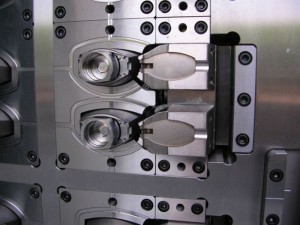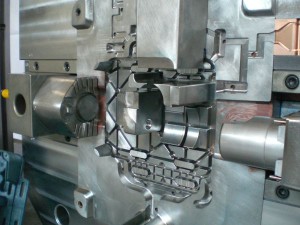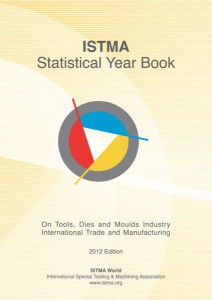Moulds and dies, in all the languages of the world
 Expo, Euro devaluation, recovery of the world trade and oil price descent are among the factors that have convinced the Bank of Italy and Confindustria to revise upwards their estimates of the Italian GDP. Mould and die makers, of which Istma certifies the good health, will benefit from the positive climate, too.
Expo, Euro devaluation, recovery of the world trade and oil price descent are among the factors that have convinced the Bank of Italy and Confindustria to revise upwards their estimates of the Italian GDP. Mould and die makers, of which Istma certifies the good health, will benefit from the positive climate, too.
The ranking of a hypothetical world Championship of the mould and die industry has been recently outlined in several occasions, starting naturally from the last congress of the sector association Ucisap, Union of Italian Manufacturers of moulds, dies and precision equipment. According to what reported by the statistical Year Book 2014 by the international association Istma World, they calculate that the primary producer States are in the order China, United States, Japan, Germany, South Korea and Italy. Concerning exports, an ideal podium lines up Japan, Germany, Korea, United States, China, Canada, Spain and, in eighth position, still the Peninsula. In import our Country ranks twelfth: it is respectively preceded by USA, Popular Republic, the unavoidable Germany, and then Canada, Japan, France, Czech Republic, Spain, United Kingdom, Sweden and Hungary. Concerning the plastic ambit only, Italy is surpassed by China, Japan, United States, Germany and South Korea: nobody, however, does better than us in non-ferrous materials. Among the manufacturers of aluminium moulds and dies and similar, Italy stands out and surpasses Germany, France and Spain. Only Japan, finally, is better than us in the die survey. Considering the upwards reviews of the forecasts about the three-colour GDP done by the Bank of Italy and Confindustria when we are writing (+2.1% this year; +2.5% in 2016) the Italian performance has the papers in order to improve further. On the other hand, even if the numbers by the International special tooling and machining association refer to 2012, experts’ opinions heard in conjunction with Ucisap’s meeting agreed in foreseeing a rosy future for the made in Italy. Moreover, it is possible that the descent of Euro quotations versus the American dollar can represent a further driver for the entire field in the next future. Looking however beyond our borders, the Yearbook by the world association has certified that two years ago the global sales of moulds, dies and relative equipment scored the 44.4% peak growth, expecting the prosecution of the rise trend for 2013. Basis for comparison is the year of the big crisis, 2009, but also in the comparison with the luckier 2008 the picture is positive, having industry scored the 8.1 percentage point increment in terms of values. In detail, we are going to see how some sector protagonists behaved according to Istma World.
 Italy: flat imports, export grows
Italy: flat imports, export grows
The rising trend of the Italian moulds and dies already brought the sector above the levels of 2008 with essentially stable imports and a continuous consolidation of the export. Forming and moulding tools attained production values that amount to 374,088 million Euros, growing by 23.2%; export rose slightly more than by 46 points and the import, dropped by 40.5% in 2010 scored instead +80% in 2011 and 2012. The output of moulds registered a positive delta by almost 50 points (1,631 billions) with exalting sales abroad thanks to their +19.1% and decreasing imports (+10.8% against +14.4 in 2011). Excluding injection ones, dies for metals and metal carbides totalled a production value of 231,538 million Euros. Exports reached the 47.2% peak (but in 2011 they were at + 52.4) and purchases balanced with +24.9% the 5.6 point descent in 2011 and the -4% in 2010. On the whole and taking also injection processes into account, sector manufacturers generated a turnover of 340,430 million Euros, (+17.4%), exports resulting in 188,987 millions (+21.4%: in 2010 they dropped by 5.7%) and their import grew from 45,345 in 2011 to 53,037 millions.
China: struggling with the rising of costs
For a long time now Beijing is facing on one hand with a growth of its Gross Domestic Product that is no longer gushing as in the past and on the contrary stabilized, with its +7.4% of the fourth 2014 quarter, at the lowest levels since 1990 until now; on the other hand, it is struggling with the rising of labour and production costs. It is not hazardous to hypothesize that these troubles can share in outlining a completely different portrait of the local mould and die business in the future Istma’s reports, because the report concerning last year still shows indicators growing by two or even two figures. This is true for forming, drilling, moulding and pressing production technologies, which lived their business growing by 102.5% concerning export and by 23.6% in imports. Constant, from 2010 to 2012, the progress of plastic injection – at the beginning of the decade it generated imports for 1,143 billion Euros; two years ago it exceeded two billions –and of solutions for metals. After their sales abroad had grown by 5% from 2009 to 2010 and by 9.8 in the following biennium, they totalled +73.8% at the end of 2012, when on the contrary imports diminished, with the 14-percentage point downturn. On the whole, the production of moulds, dies and relative technologies has progressed in the Country by 14.54% every year at constant monetary rates, since 2009.
 Germania: stability is the keyword
Germania: stability is the keyword
At the end of 2012, Istma World certified the leader ranking of Germany on a planetary scale in the TDM segment (tools, dies, moulds), emphasizing the stability that it managed to maintain in an uncertain economic survey, unlike other European nations. In detail, German producers can boast imports in constant, even if moderate, expansion and calculate an important surplus, in foreign trade, found already in the estimates regarding the past decade. Dropped by 0.8% in 2010, national production values already returned positive in 2011 (+11%), with a stabilization at +6.6%, but the export achieved much higher averages (+9.8% in 2011; +27% the following year). They are negative all the indicators about the metal field, whose production diminished by 7.5 points in 2012 after +16% of the previous year; with exports plummeted from +60 to -25.3%. The items of the plastic ambit are all positive, where stands out +10.7% of deliveries beyond the borders (+6.6%); only partially counterbalanced by the decrease (from +22.4 to +9.2%) of import, with the production at +1.8%. The imports in the metal field are rising, with the exclusion of injection, indicating that it might be possible to find room to open negotiations with German partners, which in 2012 exported much less than what done from 2010 to 2011: the datum is -0.2%, against +40.6%.
Japan: the devaluation weighs
The inflationary policies that have characterized the economic orientation of the Shinzō Abe Government (it is the so called Abenomics) have driven Japan out of the shoals of the crisis into which it had fallen in 2012 and they might continue to boost a «growth exceeding the average». The trend of the main TDM categories, until 2012, appeared anyway quite variegated. Forming instruments and technologies and similar witnessed then the 32.2% peak of exports that continued a rising trend started in 2010 (+12.5%) and consolidated 12 months later (+17.6); against decreasing purchases from abroad compared to +36% of the decade beginning, but growing, with their +36.6%, versus +7.4% in 2011. With the exclusion of injection machining, the metal area strengthened (+4%) in comparison with -5.7% in 2011, but it remained distant from +90.5% in 2010. A substantial stability, in the last examined biennium, was surveyed in the exports of plastic technologies (from +20.8 to +19.9%) and in the remaining part of those for metals. They reached +9.2 in 2010, in 2012 they were at the same level; and in 2011 at +16.1%. Concerning the values about pressing dies, in 2011, the last available updating was of 3,232 billion Euros, growing by 5%; 3,380 billions (+5.7) for moulds.
Korea: the domestic market slows down, the foreign one is driving
The values and the volumes of the imports to South Korea are «marginal» according to Istma World, at least concerning the mould and die sector. The Country is strongly oriented to export and it has brilliantly counterbalanced the slowdown of home sales with foreign ones. In 2012 it totalled its output record, calculating at the end of the year an amount of 2,34 billion dollars. The International Monetary Fund has forecast for Seoul a more and more competitive role in the global panoramas and the mould and die industry has witnessed the local boom. With a value of 602 million Euros, the export of technologies and equipment for moulding, forming and pressing grew by 36.2% versus 2011, after +13.8 of the previous biennium. Injection plastic moulds achieved 1,117 billions of export growing by 20% approximately but they scored their real exploit in 2010 with the 48.1% upsurge. Besides, the field of applications for metals held up well because, even if under the standards of the decade beginning – in 2011 and 2010 it had jumped from -16.8 to +150.6% for a turnover of 60 million Euros – it went on registering a double-figure growth of shipments beyond the borders, equal to 15.2%. In 2011, to which refer the most recent reliable estimates, the overall business of forming and moulding technologies had progressed by 13.8%, touching the value of 1,328 billion Euros.
United States: the recovery gains momentum
On the basis of considerations by primary importance Bodies like the International Monetary Fund and the Organization for the economic cooperation and development (OECD), Istma World has forecast in its Yearbook a rising 2104 and 2015-year for the United States industry and economy. Nevertheless, when the yearly book was closed the mould and die sector maintained similar values to 2008’s, distant from the levels of 2006, with imports (+57.5%) by far exceeding exports (10.6%), corresponding to 10.9% of the overall production registered in 2011. It will be then interesting to see soon to what extent the recovery of the automotive sector and of the manufacturing industry in general, energy policies and investment facilitations, the incentives of Obamanomics could affect the sector positively. After a growth by over 20 points in 2010 the production of industrial moulds and dies slightly decreased one year later (-1.7%) reaching turnover levels approaching 3.5 billions, expressed in European currency. What is certain is that in 2012 exports took an important step forward (+20.7%) at slightly less than 750 millions; imports grew instead by about 35%. Besides the export of special moulds and dies grew by 4% and in 2011 its output values had increased by a good 18 points. Technologies and equipment achieved +14.9% of sales abroad, amounting to 418 million Euros; the surplus attained, still abroad, by moulds was by 29.4% (572 million Euros), counterbalanced by imports rising by 40.5% (to 1.1 billions).
 Istma Statistical Year Book 2014 edition
Istma Statistical Year Book 2014 edition
The sixth edition of the Istma Year Book corroborates the overall rising trend of the TDM industry, following the sharp fall of 2009. Comparing with this year’s indicators, apparent market grew, on average, for the four products reported1, 44.4% in EUR 82012). First estimates concerning year 2013 confirm this evolutions. In same direction, exports outperformed this evolution, growing 56.3% (in EUR). Even when compared with 2008 figures, the data already show a growth of 8.1% – market, in EUR and 14.8% – exports, in EUR. The present edition preserves the major changes already introduced in the previous releases, and introduces two new countries: Austria and Poland. In total, the sixth edition includes twenty one countries. The total number of graphics also grows to 903. The introduction of graphics favours a rapid and clear review of the different indicators.


